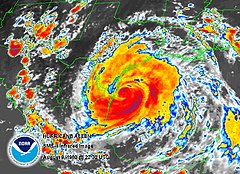Hurricane Allen
From Wikipedia, the free encyclopedia.
|
Hurricane Allen at landfall on August 9, 1980 |
|
| Duration | July 31 - Aug. 11, 1980 |
| Highest winds | 190 mph (305 km/h) sustained |
| Damages | $2.6 billion (2005 USD) |
| Fatalities | 250 - 260 direct |
| Areas affected | Windward Islands, Haiti, Jamaica, Yucatan Peninsula, northern Mexico, southern Texas |
| Part of the 1980 Atlantic hurricane season | |
Hurricane Allen was the first hurricane given a male name and the strongest hurricane of the 1980 Atlantic hurricane season. It was one of the strongest hurricanes in recorded history, one of the few hurricanes to reach Category 5 status on three separate occasions, and spent more time as a Category 5 than any other Atlantic hurricane.
Allen caused $2.6 billion (2005 USD) in damages and killed at least 250 people throughout its course.
Contents |
Storm history
Allen originated as a Cape Verde-type hurricane, a rarity for tropical systems in early August. As it moved towards the Caribbean it became the first named storm of the season. Allen sped westward, rapidly intensifying into a Category 5 hurricane and (very unusually) remaining so for over a day. The eye passed just south of Hispaniola and just north Jamaica as a Category 4 hurricane.
After weakening from interactions with the mountains of Haiti and Jamaica, Allen reintensified to a Category 5 for a second time, again retaining this intensity for over a day. It moved between Cuba and the Yucatan Peninsula. Interestingly, during Allen's trek through the Caribbean Sea and the Gulf of Mexico, its center of circulation never crossed over land despite its close passage to the islands of the Caribbean.
Allen again weakened to a Category 4 storm through interactions with land, but it restrengthened into a Category 5 hurricane for a third time as it moved over the warm waters of the Gulf of Mexico, again keeping this intensity for nearly a full day. Shortly before landfall, dry air aloft in the Gulf caused the massive storm to weaken substantially. Allen made landfall north of Brownsville, Texas as a Category 3 storm with sustained winds of only 115 mph.
Impact
Allen caused extensive damage in both Hispaniola and Jamaica. Hurricane-force winds were reported in both Cuba and the Yucatan Peninsula, along with gale-force winds in the Florida Keys.
In Texas, the storm surge was reported as high as 12 feet at Port Mansfield, though it may have been higher because the highest surges occurred in unpopulated and unmonitored sections of the Texas coast. A peak wind gust of 129 mph was also measured at Port Mansfield. The storm caused seven 7 in Texas and 17 in Louisiana (most resulting from the crash of a helicopter evacuating workers from an offshore platform). Allen spawned several tornadoes in Texas. One tornado caused $100 million in damage when it hit Austin, Texas, making it the costliest tropical cyclone-spawned tornado ever. Overall, however, the storm caused limited damage in the United States due to its suddenly diminished power and because its highest tides and winds hit a sparsely-populated portion of the Texas coast.
One bit of good news resulted from Allen's arrival -- it dumped 10 to 20 inches of rain in south Texas, ending a summer-long drought during the Heat Wave of 1980.
The name Allen was retired from the Atlantic tropic storms list in the spring of 1981 and replaced with Andrew in 1986.
Records
| Ten most intense Atlantic hurricanes Intensity is measured solely by central pressure |
|||
|---|---|---|---|
| Rank | Hurricane | Year | Minimum pressure |
| 1 | Wilma | 2005 | 882 mbar (hPa) |
| 2 | Gilbert | 1988 | 888 mbar (hPa) |
| 3 | Labor Day | 1935 | 892 mbar (hPa) |
| 4 | Rita | 2005 | 897 mbar (hPa) |
| 5 | Allen | 1980 | 899 mbar (hPa) |
| 6 | Katrina | 2005 | 902 mbar (hPa) |
| 7 | Camille | 1969 | 905 mbar (hPa) |
| 8 | Mitch | 1998 | 905 mbar (hPa) |
| 9 | Ivan | 2004 | 910 mbar (hPa) |
| 10 | Janet | 1955 | 914 mbar (hPa) |
| Source: The Weather Channel | |||
Allen is one of the few Atlantic hurricanes to reach Category 5 on the Saffir-Simpson hurricane scale on three separate occasions, the others being Hurricane Ivan and Hurricane Isabel.
Allen also produced the fifth-lowest minimum pressure ever recorded in the Atlantic basin at 899 mbar (hPa).
Allen spent nearly 3 days as a Category 5 storm, by far the highest of any Atlantic hurricane.



